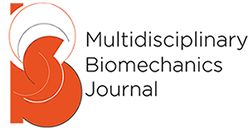 |
Aim and scope
Once a year, conference proceedings of the congress of the Société de Biomécanique are published after peer-review.
Topics
Papers published in the journal are original researches covering a wide range of topics in the field of biomechanics.
Tissue engineering and material by design
This topic is dedicated to the regeneration of tissues, by inducing cells to regenerate tissues as well as providing structural scaffolds with suited mechanical and integration properties. This disciplinary is particularly interested in:
- The design and the mechanical characterisation of optimized biomaterial scaffolds; in vitro and/or numerical approaches being involved
- The understanding of the way to promote specific cells’ regenerative processes and the design of associated bioreactors
- The experimental validations and the study of the clinical efficiency in the context of regenerative medicine
- Organoids
Cardiovascular and respiratory biomechanics
This topic is focused on understanding the role of fluid dynamics and structures involved in the functionality of the cardiovascular and respiratory systems. The associated translational research implements these innovative concepts for diagnostic or prognostic purposes. This topic is particularly interested in:
- The dynamics of blood flow and air flow at macro and microscopic scales
- The mechanics of the cardiovascular or respiratory organs, tissues, and cells
- The mechanics of the cardiovascular or respiratory prostheses/implants and devices
Cellular and tissue biomechanics
Develop a fundamental understanding of biomechanics over a wide range of length and time scales from the molecular level to the tissue level. Link these scales using mechanical modelling.
- Molecular level: molecular interactions, mechanical analysis of biomolecules
- Cell biomechanics: Biomechanical analyses of cells, membranes, and sub-cellular structures; effects of the mechanical environment on the cell response
- Tissue biomechanics: characterisation and modelling of biological soft tissues, their substitutes and of their potential interaction
Injury biomechanics and traumatology
This topic covers all areas of research devoted to understanding and modelling injury mechanisms, using all types of experimental and numerical approaches. All energy levels and boundary conditions can be considered, for the study of all types of injuries and traumatologies. By taking into account loads, the effects of geometry and material properties, but also physiological and cognitive parameters, muscle contractions or neuromotor control, it is interested in various fields such as:
- The capacity of the human body to withstand a shock with short application times (dynamics undergone)
- Potentially injurious human movements (subject actor of his movement)
- Movements and positions in constrained quasi-static environments
Motion analysis and simulation
This topic brings together research focused on human and animal motion such as:
- The development and assessment of methods and biomechanical models for motion analysis and simulation
- The study of different activities such as locomotion, balance control, prehension, etc.
Musculoskeletal biomechanics
Musculoskeletal biomechanics is a wide field of research dedicated to the characterization, modelling, and understanding of the musculoskeletal system, from the entire system to the tissue level. This area of research typically includes:
- Multibody dynamics: theoretical/numerical modelling and predictions of muscle and joint forces, asymptomatic or pathologic, using rigid bodies, deformable bodies, or coupling between them
- Tissue biomechanics: analysis of hard and soft tissue (bone, cartilage, tendons, muscles, …)
- Orthopedic biomechanics: analysis of osteo-articular system, of pathologic and artificial joints (fixation, failure, wear)
Sport biomechanics
This topic is focused on any research applying mechanic laws to sport movement with primary goals such as understanding sport movement, improving performance, prevention of sport injuries or improving return to sport. This area of research includes more specifically:
- Sport movement analysis with multi-segmental or integrative approach
- Muscular, tendon and osteoarticular mechanical properties or behavior of athletes
- Motor control and simulation of sport movement
- Interaction between athletes and sport equipment
Handicap and rehabilitation biomechanics
The objective is to analyze and evaluate situations of disability due to trauma, pathology or aging in order to propose, optimize and validate devices, technical aids, mobility aids or rehabilitation protocols to improve the quality of life:
- To measure and analyze alterations in kinematics, dynamics, motor coordination and muscular activity of movement (locomotion, grasping...) in case of deficiency, to evaluate compensation strategies and to propose clinical evaluation methods
- Evaluate the benefit and induced constraints of mobility and technical aids (wheelchairs, prostheses, orthoses...) and surgical interventions
- To evaluate, protocols for the rehabilitation of motor functions as well as preventive protocols in order to tackle frailty
Biomechanics of human-system interaction, ergonomics, and robotics
This topic deals with the interactions between man and any physical system in relation to ergonomics and robotics.
- Application of the laws of mechanics to the physical interaction between humans and mechanical systems such as collaborative robots, rehabilitation robots, passive or active exoskeletons
- Ergonomic evaluation and optimization of any device in order to reduce the incidence of musculoskeletal disorders for a better ergonomic design
- Design, control and command of anthropomorphic and/or bio-inspired robotic structures aimed at reproducing human or animal motricity (locomotion, prehension, dextrous manipulation…)
Emerging topics in biomechanics
Any emerging researches in the field of biomechanics.